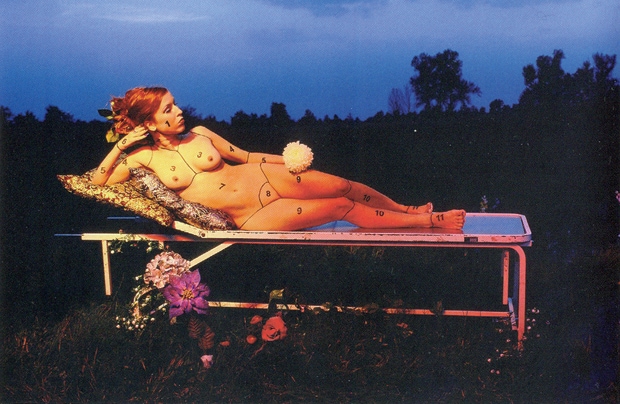Virtuosic Virtuality
However, I now want to turn to certain formal qualities present in videos produced by Wong Fu and their affiliates, and to what they might have to say about a new youth understanding of what it means to be Asian American and of how race functions for Asian Americans in our digital, Web 2.0 age.
Despite the strikingly unprogressive content of the work being produced, I am fascinated by the way in which it is delivered. In particular, these videos could be read as having interesting resonances with Walter Benjamin’s concept of the aura and Paolo Virno’s consideration of “general intellect,” “idle talk,” and “curiosity.” Many of the videos that the Wong Fu network has created—either individually or in collaboration—make great use of parody and artifice. The very first videos Wong Fu produced were clips of Wang lip-synching to pop songs in an exaggerated manner. KevJumba’s first videos as an opinionated vlogger always began with Kevin dancing and lip-synching to his introduction music at his bedroom desk in front of his laptop. NigaHiga has moved from his wildly popular tutorials on how to be “gangster,” “emo,” and “ninja,” to pop culture parodies, the subject of which range from reality TV shows, to blockbuster movies, to satirical infomercials.
Undoubtedly this trend is informed by the use of YouTube as a primary medium. Parodying popular culture helps generate hits from users searching for the original work, while the length restrictions of the video-clip format and the short attention spans of Internet browsers almost necessitate the exaggerated performance qualities so prevalent among Asian American YouTube stars. YouTube also functions as an audition stage for young, undiscovered talent trying to cross over to the mainstream. But the limitations and functions of the format notwithstanding, where else might the impulse towards playful parody, exaggeration, and mimesis come from?
Alexander Weheliye has argued that “because New World black subjects were denied access to the position of humanity for so long, ‘humanity’ refuses to signify any ontological primacy within Afro-diasporic discourses.” 1 This relationship to liberal humanism, Weheliye suggests, has in turn informed the increased virtuality of black music. I am interested in applying a reading similar in structure to Weheliye’s to the peculiar virtuality of the YouTube videos discussed. Just as black hip hop and R&B artists might sample, scratch, or use a vocoder in their music, “persistently emphasiz[ing] the virtuality of any form of recorded music”—and thus its lack of concern with authenticity—Asian American YouTube filmmakers deploy highly visible editing techniques (fast cuts, exaggerated lighting, text captions) and sample, parody, and reinterpret popular cultural touchstones in ways that highlight the virtuality of the resulting video. I would also like to suggest that the virtuality of such YouTube filmmaking—the lack of investment in producing “authentic” media—is tied to the particularities of the racial positions that young Asian Americans occupy within the United States. The term “Asian American” was coined relatively recently—along with ethnic studies in the 1960s—and the definition of who is included within this term has fluctuated and expanded since then. In comparison with other racial groups in the United States, Asian Americans are consistently ranked as the most heterogeneous by most demographic measurements—from country of origin to class or political views.
That the racial category of Asian American has no ontological primacy is, I believe, quite apparent to many of those who fall within its boundaries, including young Asian Americans who have taken up the term. Members of Wong Fu have said in interviews that others applied the term Asian American to their work after the fact (Yellow Fever never uses the term), and that the identification of their work with a burgeoning Asian American youth consciousness was unintended—although they have since taken it in stride. (Although there is certainly an argument to be made that this is a marketing strategy rather than the development of race consciousness, Wong Fu’s promotion of itself as part of the new vanguard of Asian American filmmakers through press, college tours, and their own videos has introduced many young people to the term and its concept of community.)
Given the “virtuality” of the category of Asian American itself, I would like to read YouTube virtuality in the context of Walter Benjamin’s discussion of the loss of “aura” in “The Work of Art in the Age of Mechanical Reproduction.” Specifically, how might the recognition of the virtuality of Asian American result in the loss of a certain “racial aura?” That is, when Asian American YouTube personalities mechanically reproduce racial stereotypes, is there actually room for the reconceptualization of such stereotypes for the purposes of political mobilization along racial and ethnic lines, just as Benjamin envisioned along lines of class? When KevJumba makes yet another video mock complaining about his Chinese-immigrant father’s obsession with his grades, does the play of self-parody actually provide a fruitful confusion and distance, a recognition of race as performance?
To be clear, KevJumba’s videos are not the radically subversive acts themselves. Just as Benjamin criticized the fascist aestheticization of war as an example of the dangerous turn mechanical reproduction could induce, I am wary of the aestheticization of racism that Wu and others sometimes appear to set forth. As Benjamin made clear, the mass-market films of his time were revolutionary only in their critique of traditional notions of art; this current crop of YouTube stars make films that are more notable for the representation they give to Asian Americans in the entertainment industry than for any political, antiracist content. I am, however, trying to point out sites of potentiality that might help reconfigure a more dynamic Asian American political coalition. Of course, keeping Puar and Rai’s critique in mind, if mechanical reproduction can harness the power of a collectivity to mobilize politically, it must not be in terms of equation and resemblance, but communication of difference, singularities.
To that end, I would like to introduce Paolo Virno’s A Grammar of the Multitude, and how reading Asian American virtuality might open up new configurations with which to answer Puar and Rai. If the general intellect—however much a manifestation of the ever-growing pervasiveness of capital in the post-Fordist era—signifies a breaking down of public and private, individual and communal, might there be some room for communication of singularity? The virtuality of Asian American YouTube productions might productively facilitate foundationless idle talk—what Virno calls “communication, [which] instead of reflecting and transmitting that which exists, itself produces the states of things, unedited experiences, new facts.” 2 Similarly Asian American virtuality might produce sites of distracted curiosity, “a certain level of dispersion and inconstancy.” 3 This dispersion and inconstancy means not simply a passive consumption of what is being presented, but a certain distracted dynamism that neither claims to wholly know or master anything nor makes any claims to the real and authentic.
What has seemed, for many readers, so terrifying and severe about Virno’s account is, of course, that virtuosity—that activity “which finds it own fulfillment … without objectifying itself into an end product” and which also “requires the presence of others” 4 —is no longer an activity reserved for the culture industry, but is instead emblematic of the social organization of labor in the post-Fordist era as a whole. Capitalism no longer simply demands our labor for nine hours behind the retail counter or office desk but now commands our language, imaginations, and dreams. We no longer have to make physical objects in order to provide value for capital. Virno’s breathless treatise has limits, certainly, especially—given this paper’s subject matter—that he takes as his subject only capitalism, and not other forms of power more broadly. If we think about racism, colonialism, and heteropatriarchy—none of which are reducible to being functions of capitalism—perhaps imagining that racism has infiltrated our imaginations and dreams, that colonialism has exploited our language in order to further itself, and that power co-opts are not such startling concepts. Nonetheless Virno can provide us with the conceptual tools to understand how political economy comes into the lives of our YouTubers and us: the audience, the multitude. When NigaHiga makes a video and we watch it, we are all laboring in the service of power. We consume the advertisements that play before his videos and provide revenue and personal data for YouTube. NigaHiga bears the costs of production himself; his pay is pegged to how much of our attention and data he can provide for YouTube. But YouTube labor is more than just productive labor. It is surplus-value labor; it is virtuosic. As Virno reminds us, it is not that in the post-Fordist era workers no longer make car dashboards, but that they make immaterial products in the process as well. Thus NigaHiga does not simply make videos, but produces an entire way of communication for his audience, which is indicative of the post-Fordist “industry of the means of communication.” 5





